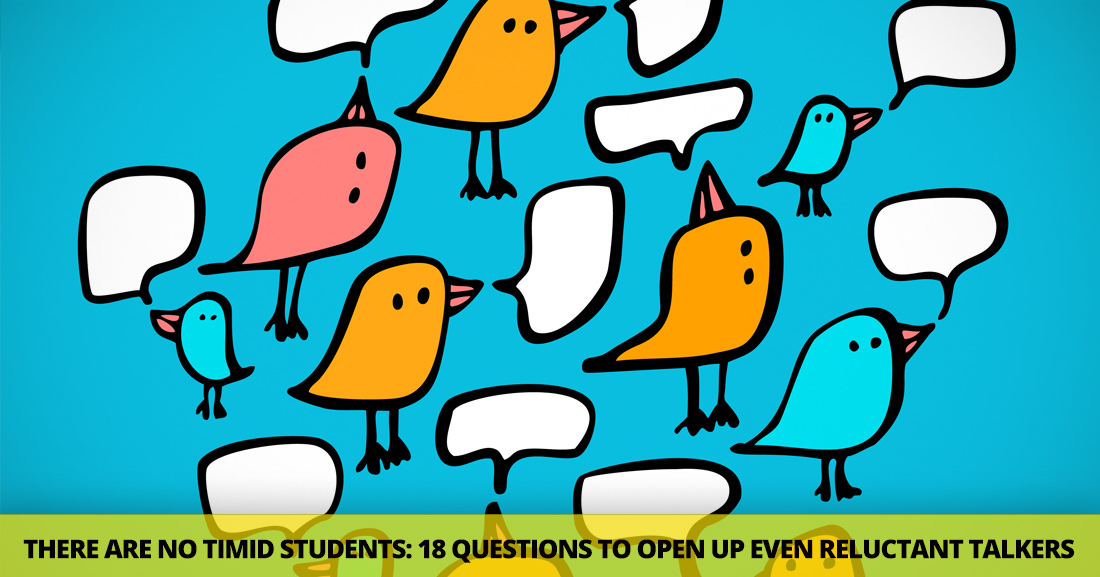There Are No Timid Students: 18 Questions to Open Up Even Reluctant Talkers

![D - Dream Big: How To Teach Talking About Dreams, Plans and Strategies [Teacher Tips from A to Z]](https://m.busyteacher.org/uploads/posts/2011-07/1310532998_dream-big.png)
Dreams are something that a person encounters every day. Whether you are dreaming big or running from a nightmare, these activities will give your students opportunities to talk about their dreams and further their English skills in the process.
Let’s Talk
Introduce your students to the idea of dreams by showing a clip from The Wizard of Oz, a movie that they have probably already seen. A good scene is the end of the movie when Dorothy wakes up from her dream after the tornado. If your students are younger, you may also want to share the book Ben’s Dream by Chris Van Allsburg. Then ask them what it means to dream. Can they think of any other examples from books, movies or television where the characters wake up to find that everything has been a dream? Encourage your students to share their ideas.
Then ask your students what types of dreams they have had. They will most likely share dreams they have had when sleeping. Most dreams that students will remember will be ones that have touched on strong emotions. They may be dreams that were funny, frightening, silly, weird, sad or fanciful. Divide your class into small groups and allow them to share their dreams with one another. This is a good time for you to get a candid measure of their English skills. When people become emotional, their speech will revert to its most natural state. If you can listen to all of your students during this activity, you will know what English issues with which they struggle. After the discussion, give each group a chance to share one or two stories they found most interesting. You can ask that another person in the group retell a classmate’s dream.
Now introduce the concept of a dream being something you hope to achieve in the future, and teach your students the phrase dream big. Share one of your dreams whether it is to travel or make a special purchase. Then have your class reform into their groups and share this type of dream with one another. Before you do, though, you may need to review the structures “I hope to…” and “I would like to…” Also, encourage your students to start their explanations with some day, one day, or in the future.
Plan Ahead
At this point, your students may have a good idea for a dream they would like to write about. If they have decided on one dream for the future that they would like to write about, give them an opportunity to compile some details about the dream by using a cluster map. In a cluster map, your students should put the topic of their dreams in the center of a page and put a circles around them. From that center circle, students should draw spokes that reach out to other circles. These other circles will hold the details about the dreams. You may want to have your students draw six spokes and write along each spoke one of the question words: who, what, where, when, why and how. They should then answer these questions about the dream they have for the future. By getting these ideas down on paper before writing the essay, your students will not be floundering for ideas in the middle of the writing process. It will also be easier for them to organize the essay before they write. Now give your students time to write out their dreams or assign it for homework. You may also want to design a bulletin board where you can display what your students have written. Encourage your students to read about one another’s dreams and talk to their classmates about them.
Strategize
After your students write about their dreams, let them strategize how to achieve those dreams with this activity. Write the phrase five-year plan on the white board. Ask your students if any of them know what a five-year plan is. If no one can explain a five-year plan, ask a volunteer to explain what a plan is. Then have them guess at what a five-year plan would be. Help them understand that a plan is more definite than a dream so the verb tense to use when writing a five-year plan is the simple future. In one year, I will… In three years, I will… Have your students think about their dreams and create a five-year strategy for achieving their dreams. If they cannot achieve the dream in five years, allow them to create a ten-year plan. If time permits, allow each student to share his five-year plan in front of the class and allow the class to ask questions and offer advice. Remind the presenter to use simple future for definite plans or to use may or might when talking about possible actions in the future.
It will help your class to get to know each other better and may also give your students some useful plans for achieving their dreams.